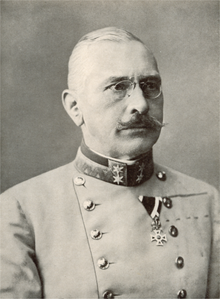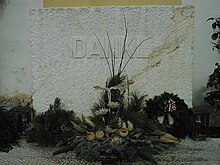Viktor Dankl von Krasnik
Viktor Dankl von Kraśnik | |
|---|---|
 Count Viktor Dankl von Kraśnik | |
| Born | 18 September 1854 Weiden in Friaul, Kingdom of Lombardy–Venetia, Austrian Empire (present-day Udine, Friuli-Venezia Giulia, Italy) |
| Died | 8 January 1941 (aged 86) Innsbruck, Reichsgau Tirol-Vorarlberg, Nazi Germany |
| Allegiance | |
| Service/ | |
| Years of service | 1874–1918 |
| Rank | |
| Battles/wars | First World War |
| Awards | Military Order of Maria Theresa |
Viktor Julius Ignaz Ferdinand Graf
Early life and career
Viktor Kraśnik was born in the then
Upon completion of the academy, Krasnik was assigned to the Third Dragoon Regiment as a Second Lieutenant. After completion of the War School in Vienna, he became a general staff officer in 1880. For the next two decades, he rose through the officer ranks, becoming the head of the central office of the Austro-Hungarian general staff in 1899. In 1903 he was promoted to the rank of major general and given command of the Sixty-sixth Infantry Brigade in Trieste. From 1905 until 1907 he would head up the Sixteenth Infantry Brigade, also in Trieste. After being promoted to a lieutenant Field Marshal (Feldmarschalleutnant), Krasnik would receive command of the Thirty-sixth Division in Zagreb until 1912, at which point he was moved to Innsbruck to command the Fourteenth Corps. Later that year, on 29 October, Krasnik was elevated to the rank of General of Cavalry.
Service during World War I
At the beginning of war in summer 1914, Krasnik was put in command of the
After being driven back by Russian forces Krasnik and his First Army were part of a renewed offensive in October 1914 that was undertaken with the German forces to the north and west. Gains made during this drive proved to be only temporary as more or less of a stalemate developed in Dankl's area. The First Army did not see much action during the winter of 1914-15 and were held as reserves for more active
On 23 May 1915 Italy declared war on Austria-Hungary and Dankl was soon reassigned to the resulting
In March 1916 Krasnik was given command of the
Resignation, later career, and retirement
Dankl was criticized both by Army Group Command (Archduke Eugen) and by the Austro-Hungarian Supreme Command (Conrad). He had ignored an order given by Archduke Eugen to advance at a faster pace, disregarding the lack of artillery. How much Dankl's slow and steady style contributed to the stalling of the Asiago offensive is debatable. These charges and complaints, coupled with his very real health problems, caused the general to send a letter of resignation. On 17 June 1916 he was dismissed from command. His Eleventh Army chief of staff, Major General Pichler, was also relieved of his position.
After undergoing an operation on his throat, specifically a goitre, he was assigned command of the First Arcièren-Leibgarde, part of the Imperial Guards, on 21 January 1917. Dankl rose to commander-in-chief of the Imperial Guards in February 1918 until he was replaced at that post by Conrad, his former superior officer during his time at the front, the following summer. He returned to the First Arcieren-Leibgarde, where he remained until the end of the Habsburg rule over Austria-Hungary. He was retired from the army on 1 December 1918 and moved to Innsbruck.

In 1925 Dankl would assume the chancellorship of the Maria Theresa Order. This time he would be replacing a position held by Conrad, who left the vacancy upon his death that year. For the next six years he would be in charge of decorating Austro-Hungarian soldiers from World War I. He undertook this task with much enthusiasm, becoming an outspoken apologist of not only his fellow veterans but of Austria-Hungary in general. He even went so far as to advocate the return of the monarchy, putting himself at odds with the growing support of Austrian Nazi groups for Hitler and Germany. He was a firm opponent of the Anschluss, favoring an Imperial Austria under Habsburg to a Nazi German Reich under Hitler until the end. He refused totalitarianism, fascism, antisemitism and the Second World War. By the time of his death he was seen as a stark anachronism, out of step with the new era of the Greater German Reich. On 8 January 1941 Viktor Dankl died at the age of eighty-six. His wife had died a mere three days earlier. He was buried in the churchyard of Wilten Basilica in Innsbruck and his grave can still be visited. Due to his well-known anti-Nazi stance, the Wehrmacht was ordered not to honor Dankl with any sort of military ceremony.
Honors and decorations

Throughout his mostly distinguished career, Dankl was the recipient of a large amount of military and non-military awards. Despite his reputation as being somewhat short tempered, he was noted as one of Austria-Hungary's finer generals of World War I by Conrad.
On 17 August 1917 Dankl was decorated with the Commander's Cross of the Military Maria Theresa Order in recognition of his services during the battle of Kraśnik. In accordance with the statutes of this order, Dankl became a baron in his country's nobility and was since styled "Freiherr von Dankl". In 1918, Emperor Charles I further advanced him to the degree of count and granted him the territorial title of "Kraśnik", after which he was styled "Graf Dankl von Krasnik". This makes Dankl a rare example of a person in Austria who was born a commoner but rose to the title of count. In 1925, he was appointed as Chancellor of the Military Order of Maria Theresa as a successor to Conrad.
His military awards include: the Commander's Cross of the
Civilian honors include an honorary
Notes
Regarding personal names: Until 1919, Graf was a title, translated as Count, not a first or middle name. The female form is Gräfin. In Germany, it has formed part of family names since 1919.
References
This article includes a list of general references, but it lacks sufficient corresponding inline citations. (December 2015) |
- Chisholm, Hugh, ed. (1922). . Encyclopædia Britannica (12th ed.). London & New York: The Encyclopædia Britannica Company.
- Spencer Tucker (2 September 2003). Who's Who in Twentieth Century Warfare. Routledge. pp. 70–. ISBN 978-1-134-56515-3.
- Spencer C. Tucker (28 October 2014). World War I: The Definitive Encyclopedia and Document Collection. ABC-CLIO. pp. 442–. ISBN 978-1-85109-965-8.
- Spencer C. Tucker; Priscilla Mary Roberts (September 2005). Encyclopedia Of World War I: A Political, Social, And Military History. ABC-CLIO. pp. 334–. ISBN 978-1-85109-420-2.
